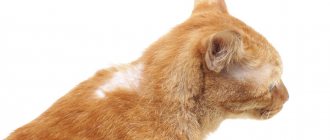Scratching in cats is not considered a big problem, but only until the wounds are bloody or cover a large area. The speed of development of events is also frightening, since most often the cat itches a little, and after 10–12 hours bleeding wounds appear on the pet’s skin. Such a horrifying picture does not pose a serious danger as long as the wounds are not infected. The cat is in pain, nervous, eating poorly, anxious, how can you figure out what to do?
Treating scratches at home
Most often, the owner decides to observe the development of events; in the end, the cat may itch due to nervousness. If the cause is not determined correctly, the situation worsens and scratching becomes painful. The progression of the disease can be determined by the reaction of the animal, which does not allow the scratches to be examined or simply hides.
There is another scenario for the development of events - the external scratching is delayed, and the infection that has “settled” on open wounds goes into the deeper layers of the skin. This happens for two reasons - complete ignorance of the problem or treatment of the animal’s skin at random.
Simply put, when you see a scratch or scratch, you should not smear it with all the ointments that can help; it is better to adhere to the standard treatment regimen or consult a doctor. If abscesses and boils form, you need to consult a doctor, since for recovery you need to remove the infection from the deep layers of the skin as quickly as possible. If the veterinarian doubts that the cat's immune system is functioning at full strength, non-steroidal anti-inflammatory drugs may be prescribed.
Note! Scratching is called a hot spot because the body temperature in the affected areas is usually higher than the base temperature.
If the inflammation does not seem extensive or painful, treatment at home comes down to preventive measures. If you do not allow infection to occur, and the cause of scratching does not lie in illness, the wounds will heal within a few days.
To disinfect and relieve discomfort, wounds are wiped with non-alcohol tincture of calendula. It is best to buy a collection of herbs and make a decoction yourself. If you need to act quickly, and only an alcohol solution is on hand, you need to fill it with hot water or boiling water so that the alcohol evaporates as quickly as possible.
Local discomfort is successfully relieved with cool lotions. For cooling, you can use herbal decoctions - oak bark, calendula, chamomile , etc. You need to be careful with lotions because wounds need to dry out to heal. By the same logic, scratches should not be bandaged or sealed. If the cat actively licks wounds, use an Elizabethan collar or follow the regimen prescribed by the veterinarian.
Note! If a cat has scratches on its head, the use of a collar is mandatory and the main danger is not infection of the wounds, but in causing a traumatic brain injury during scratching with its paws.
If you want to rid your cat of scratching, you need to heal not the wounds, but the reasons for their appearance. The word comb comes from “to itch”, which means that the cat is bothered by itching. You need to understand that when the skin just itches, the animal does not tear the skin to the point of wounds.
Treatment of scabies in a cat
Early treatment will help quickly cure an infected cat and prevent infection to other pets and humans.
Pre-medical measures
First of all, it is necessary to isolate the cat from other animals and family members to prevent the spread of the disease. For the same purpose, it is necessary to disinfect all pet care items. Boil food and water bowls, beds, blankets and bedding that may have gotten scabies mites.
Home Remedies
Until the doctor prescribes treatment for your cat, you can use home folk remedies. But remember that most of them have no proven effectiveness. If the animal does not get better, be sure to visit a veterinarian. Perhaps the doctor will allow some of these remedies to be included in the complex treatment of scabies.
Essential oils
Almond, lavender and tea tree oils have repellent properties and relieve skin irritation, swelling and inflammation. A few drops of oil are applied to the animal's skin, rubbing them in a circular motion. To enhance the effect, you can mix two types of oil and add one capsule of vitamin E (sold at the pharmacy). All procedures must be performed with latex gloves.
Course of treatment: 2-3 times a day for 2-3 weeks.
Sulfur and sulfur-tar soap
Sulfur copes well with harmful parasites. In addition, this soap has an antibacterial and antifungal effect. Simply bathe your cat with sulfur soap - this will stop the spread of mites.
The bathing procedure is performed once, after which the treatment is continued with other external means.
Boric acid
A solution of boric acid (sold in a pharmacy) is used to treat affected areas of the skin. It is especially convenient to treat the ears and the area behind the ears.
The affected areas are treated once a week until the cat is completely cured.
White vinegar
Vinegar is diluted in water and the mixture is sprayed onto cat hair. Care must be taken not to get it on affected areas of the skin or open wounds - vinegar causes severe irritation.
Apply 2-3 times a day for 10-15 days.
Buckthorn bark
Crushed buckthorn bark (2 tbsp) is poured with boiling water and left in a water bath for 15 minutes. Strain, cool to room temperature and rub the resulting infusion into the skin of the animal 2-3 times a day for 10-14 days.
Bay leaf
Bay leaves are crushed in a blender and mixed with butter. The resulting mass is applied to the affected areas of the cat’s skin 2 times a day for 10-14 days.
Corn oil
Corn oil can be purchased at any supermarket. It is rubbed into the affected areas of the cat's skin for 2 weeks.
Professional treatment
Treatment of scabies in a cat is always a complex of measures. Depending on the severity, the doctor may prescribe the use of special ointments and lotions based on tar and sulfur in combination with intramuscular antibiotics, if necessary.
The course of treatment averages from 1 to 3 weeks.
Amitrazine or sulfur ointment is usually prescribed externally. In the form of subcutaneous injections - the drug Ivermectin, which is used for 7 days, 1 ml per 25 kg of animal body weight. Please note that using this drug without consulting a veterinarian is dangerous, especially for kittens.
It is also possible to additionally use special medicated shampoos. And the doctor will definitely prescribe vitamins and immunostimulants to strengthen and activate the body’s defense systems.
After eliminating the acute symptoms of the pathology, it is possible to use special collars and drops against fleas and ticks for cats as an additional method of treatment and prevention.
Important!
Be sure to treat cat toys, favorite resting places, beds and scratching posts with insecticidal preparations.
Preparations for scabies
In the complex treatment of scabies in cats, external preparations (drops, ointments, solutions, medicated shampoos) and injections (injections) are used.
Popular drugs:
- Sulfur ointment is simple. The most popular remedy for treating scabies. The active ingredient is sulfur. It destroys adult ticks and their larvae. Sulfur has no effect on parasite eggs.
A long course of treatment is necessary so that all individuals have time to hatch and die. The ointment is applied in a thin layer to the skin 1-2 times a day. The course of treatment is 7-20 days. Price: 55 RUR/21 UAH.
- Amitrazine is an oily solution for external use. The active ingredient is amitraz. To soften the effect and accelerate skin regeneration processes, rapeseed oil is included in the acaricidal preparation. Dimethyl sulfoxide has an analgesic and antimicrobial effect. Acts on ticks, their larvae and eggs.
The drug has a cumulative effect, which provides preventive protection after a course of treatment. The drug is applied to the affected skin with a cotton pad 2 to 5 times. The interval between procedures is 5-7 days. Price: 70 rub./13 UAH.
- Aversectin ointment . The active substance is aversectin, which has an insectoacaricidal effect. Causes paralysis and death of scabies mites in all stages of its development.
The ointment is applied to diseased areas of the skin using a spatula, the treatment is repeated 2-5 times with an interval of 5-7 days. Price: 60 rub./33 UAH.
- Ivermectin . A broad-spectrum antiparasitic drug that kills both external and internal parasites. The drug is administered by injection.
One injection is enough. The dosage is calculated based on the cat’s weight - 0.1 ml/5 kg of the cat’s weight. The effect after injection of the drug lasts up to 2 weeks. Price: 420 rub./108 UAH.
- Advocate. Drops on the withers against scabies mites, fleas and helminths. The drug is used as part of complex therapy. Apply once. The contents of the pipette are applied to the skin in the area of the cat's spine. Price: 1390 rub./690 UAH.
Diagnosis of scratching and itching
Itching is probably one of the most unpleasant sensations that can only be relieved by scratching. It has been proven that a person can become psychotic if they experience itching and cannot scratch themselves. Itching in an animal is a clear sign of skin damage, although it can occur before obvious symptoms appear. In veterinary medicine, as in human medicine, itching is distinguished depending on its nature:
- Localized – one or more specific places are itchy, for example, scratching appears only on the face or on the neck and cheeks.
- Generalized – when the cat’s entire body itches.
Prevention
Both purebred cats (British, Scottish Fold, Maine Coon) and outbred pets are susceptible to sores and scratches due to itching around the ears, on the stomach and back, and limbs. To protect your pet from skin diseases, you should protect your cat from contact with sick animals and carry out regular treatment with flea and anthelmintic agents. Cosmetics for care and food should be chosen of high quality, with natural additives. Purchase industrial food products that are hypoallergenic. Carry out hygienic cleaning of ears and eyes with special means. It is recommended to periodically disinfect the sleeping area.
Causes of scratching
The first thing the doctor will do is examine the animal for the presence of parasites. Flea scratches appear all over the body, most often on the cheeks, neck, chin and at the base of the tail. In most cases, even if the animal has recently been treated, parasites are the cause of the itching.
The cat itches because the saliva of blood-sucking parasites always causes an allergic reaction. If you have ever been bitten by a flea or tick, you know that the bite itself is not felt, but afterwards it itches a lot. Flea saliva, injected under the skin, acts as a pain reliever, but since it has a protein base, after some time an allergic reaction occurs.
Note! The development of a flea allergy does not always imply the presence of a large number of parasites; for cats with sensitive skin, a few bites are enough for scratching to appear.
The next most popular reason is microscopic mites. Itching from mites is incomparably stronger than allergic; the area affected directly depends on the method of parasitism. For example, when infected with ear mites, a cat scratches the skin near the ear, forehead and back of the head within 24 hours. The subcutaneous mite can settle on the back, body, under the arms or even on the tail. To confirm or refute the diagnosis, a scraping is taken from the damaged skin for laboratory examination.
During laboratory analysis, scrapings are also checked for the presence of spores, which will indicate a fungal infection of the skin. Cats, dogs and people constantly have fungi and microorganisms living on their skin; not all of them are friendly, but the symbiosis is designed so that the bacteria do not attack the host. When the level of immune defense drops or an active, unfriendly culture is introduced, the cat may develop microsporia, which for many is more commonly called lichen.
Statistically, cats are more likely to get ringworm, but are practically not susceptible to other skin ailments. If the diagnosis is confirmed, the veterinarian will prescribe a course of treatment. Typically, treatment for ringworm involves injections or oral medications. Scratching should be smeared with antiseptic ointments with an antifungal effect.
Important! The symptoms of itching and allergic skin reactions are very similar (redness of the skin, itching, scratching), but are treated differently.
Why does a cat scratch its neck?
There are many reasons that cause itching other than flea infestation. The problem may lie either in the activity of other parasites or in individual intolerance to certain substances.
Parasites
When the most obvious cause of neck scratching, namely fleas, has been ruled out, you should not immediately stop looking in this direction, because other types of parasites may also bother the animal. So, itching can be provoked by:
- Subcutaneous mites that cause demodicosis - a disease that affects the skin and coat of a pet. In the localized form of the disease, the lesion occurs in a separate area of the body, for example, on the neck. In this case, the skin turns red, pustular rashes appear, the integument peels off, and the hair on the head, ears and neck falls out. The animal is primarily concerned about severe itching and the appearance of bleeding wounds, which are further scratched with claws. Cat subcutaneous mites of any kind are not infectious to humans. Two types of such parasites can live on a cat’s body: Demodex cati, which is conditionally pathogenic (it is part of the normal flora, but under favorable conditions it can multiply and cause disease),
- gatoi, a scabies mite that belongs to a pathogenic species and can be transmitted from one individual to another.
The gatoi scabies mite causes severe itching in cats and can be transmitted to other pets, but not to humans.
Dermatological diseases
Skin diseases can be caused by both changes within the body and pathogenic microorganisms:
- Fungal dermatological diseases (dermatomycoses) are a common cause of problems in cats, caused by mold and yeast infections. The most common disease in this group is lichen, the causative agent of which is the fungus microsporum, epidermophyton or trichophyton. The disease affects the hair follicles and skin. Ringworm is contagious and can be easily transmitted from cat to person, so owners should be vigilant, especially if there are small children in the house. The disease manifests itself in symptoms: round redness appears on the body, which itches and bothers the animal;
- peeling of the skin and hair loss are observed, which most often affects the area of the head, neck and limbs;
- When a secondary infection occurs, scratching can transform into festering wounds.
Ringworm most often affects the head, neck and extremities, causing itching, flaking skin and hair loss.
- traumatic - due to mechanical damage to the skin on the neck, burn or frostbite;
Allergic reaction
A nonspecific immune reaction to an irritant can occur in animals as often as in humans. Possible allergens that can cause itching in the neck area:
- feed;
- flea drops on the withers and an anti-flea collar;
- medications;
- shampoo and other hair care products.
An allergic reaction can be limited to local itching and redness, which causes the animal to itch a lot, or cause additional, more dangerous symptoms, including life-threatening swelling of the airways (Quincke's edema).
Video: a cat has an allergic reaction to a flea collar
Allergies as a cause of itching and scratching
If all of the above reasons are excluded, the doctor will assume an allergy.
Food allergies
If you're lucky, the allergy will be food, that is, caused by eating foods or feed that are not entirely suitable for the cat. Food allergies are identified by taking a detailed history. It is important to remember what you fed your ward for the last 10 days, did you change the food, did you treat it from the table, etc. To alleviate the condition, the animal is transferred to a neutral diet and supported with antihistamines. How to recognize allergies in the video below:
Routes of infection
The most common route of infection with cat scabies is contact. The microscopic tick can easily jump from one infected animal to another. Moreover, it is absolutely not necessary to contact sick relatives. A cat can become infected from a dog, from another cat, or from birds - domestic or wild. Pigeons are especially prone to scabies.
This can happen anywhere: during a walk, at a veterinarian’s appointment, at an exhibition, on public transport. Small kittens often become infected from their sick mother during the period of cohabitation and feeding.
The second common route of transmission of parasites is through animal care items. You can pick up a tick from someone else's comb, brush, or bedding. The third is housekeeping clothes and shoes. A person can bring ticks into the house on their clothes or shoes.
Who is at risk
Most often people become infected with scabies:
- Animals with weakened immune systems.
- Exhausted cats.
- Pets in shelters and stray cats.
Stress and mental disorders
It is rare, but it happens that scratching in cats is associated with a mental disorder. Most often, the wounds resemble scratches, but are not them, since the cat is actively licking itself. Wounds form on the paws and shoulder blades. The size and depth of the wounds is rapidly growing, but despite the pain. the cat continues to lick itself.
Assumptions about neurosis are relevant if all of the above reasons could not be confirmed. The diagnosis is confirmed by prescribing a course of sedatives, if the cat begins to actively lick itself and the wounds begin to dry out - the reason is stress.











